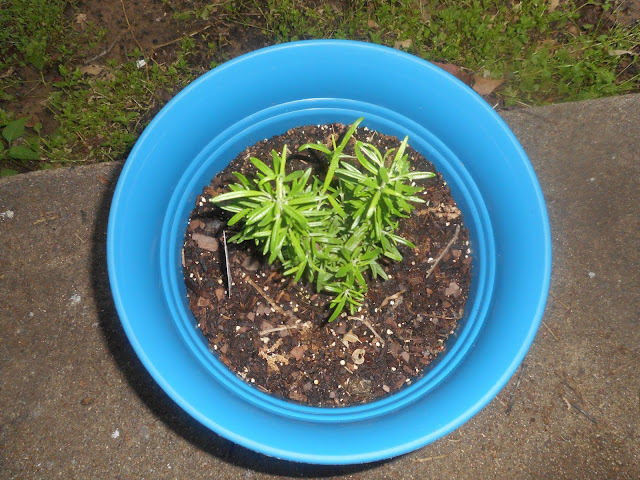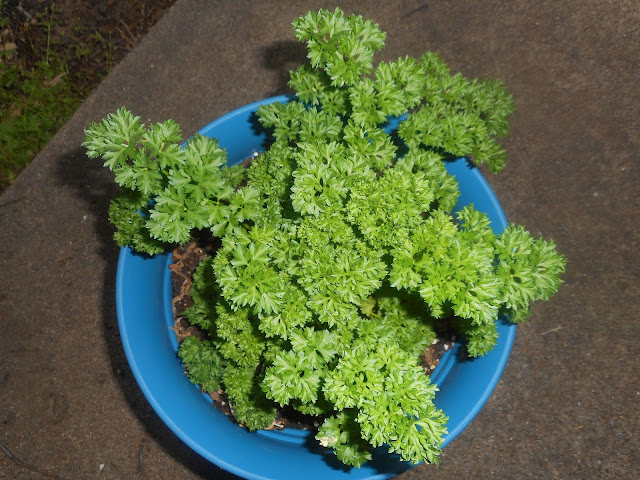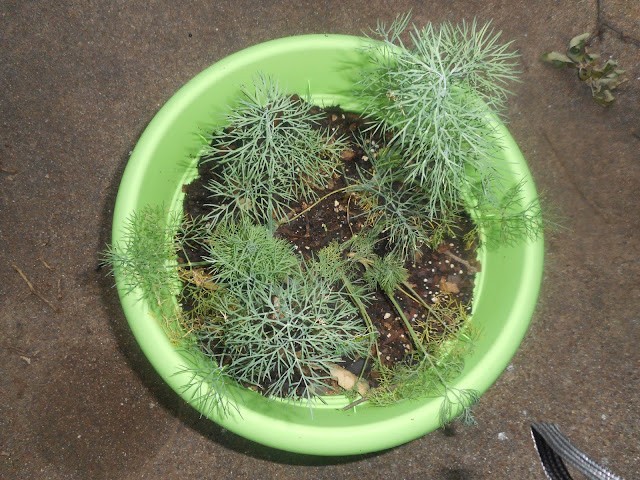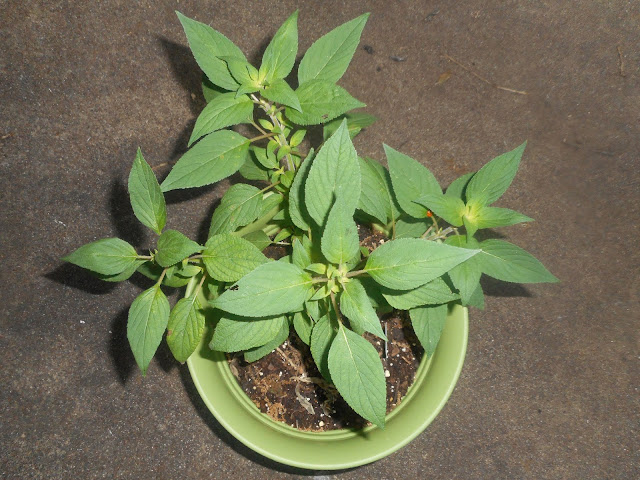Instead, I'm going to create a series of posts, as I learn about caring for these culinary delights.
Yesterday, I decided to cook a pot roast since they were on sale at Albertson's for 2.49 a pound. We like Grill Mates Montreal Steak Seasoning and rosemary on our steaks, so I decided to do the same thing to the beef chuck roast.
Since I didn't quite know how to snip the rosemary off the herb growing outside, I had to do a little research on how to cut herbs for cooking; and I am so glad that I did.
I honestly would have done it wrong!
Trimming and pruning your herbs encourages the plants to grow bushier and produce more foilage for your recipes, so you'll want to do this even if you don't plan on using the herb right away.
But you don't want to touch your plants until they are at least 6 inches high or, at bare minimum, when they have 2 to 3 clusters of leaves going up the stems.
This means, I only had enough rosemary leaves for just the pot roast, due to rosemary being a woody herb, but clipping the rosemary yesterday will encourage the plant to grow more leaves.
No matter what type of herb you're growing, you'll want to make sure that you know how to cut those herbs properly, so you don't accidentally harm your plant.
And with that in mind, I decided to do research on all of the herbs and plants I'm growing in pots right now. That way, I'd already have the cutting information handy when I wanted to clip something else.
Glad I did, because the basil is flowering, which means it's overdo for a little bit of pruning.
Cutting Herbs for Cooking - General Information
Since my basil is flowering, I'm going to pinch off the flower today.
Like all herbs, you want to keep your plants from flowering because it will change the flavor of the herb and cause the plant to stop growing. Energy will go into the flowers instead of the leaves.
Trimming herbs encourages them to be more bushy and grow larger. Thus, providing a much higher yield. Rosemary, basil, and dill are some of our favorite herbs, so getting them to grow larger is important for us.
The nice thing is that you can use the clippings in your low-carb cooking.
You're going to need 3 times as much fresh herbs as you do for dried, so if your recipe calls for 1 teaspoon of dried rosemary, you'll need a tablespoon of the fresh.
If you can't use the herb right away, you can leave the leaves on the stalks and hang the stalks upside down for 2 weeks to dry. Some people simply toss their herbs into a brown paper bag for those two weeks, while others use a dehydrator.
You can also freeze herbs in ice cubes for later use.
Rosemary
Rosemary prefers moist potting soil, but not so moist that the roots are wet. It doesn't do well with wet roots, so if you are planning on creating your own herb garden, make sure that you don't over water the rosemary.
When you go to cut rosemary for your low-carb recipes, you want to trim the stalks above the woody brown part of the stem.
You also want to make sure that you leave at least one set of new leaves growing out of the stalk above that woody part, so it can branch out into two more branches.
Cutting the stalk off above the new leaves will encourage the plant to grow those leaves into two more branches, which is why it's important to keep your herbs well manicured. Every cut will double the amount of branches you have.
To use rosemary, you pull all of those leaves off the stem, including the newer leaves that look like needles, and chop or mince them up for your recipes.
Oregano
Oregano is a good source of Vitamin K, which is important to us since celiacs tend to be low in that vitamin. It's also an antioxidant, an antibacterial, and also contains a hefty amount of omega 3's.
Like most herbs, you want to keep the tops trimmed back to avoid flowering.
Oregano is also a woody herb, so when you do your cuttings, stay above the woody stem and snip just above a set of leaves. If the plant is large, go only about 1/3 of the way down the stem, unless you're trying to revitalize an older plant.
Like Rosemary, you're going to pluck the leaves from the stem and chop or mince them up for your recipes.
Sweet Basil
 |
| Don't let your basil plant flower like this one. Pinch out the flowers as soon as you see them start. |
Basil is a fast grower, so you'll need to prune about every couple of weeks, or so. Make sure that when you cut, you stay above a pair of new growth shoots.
Chop or mince the leaves.
Parsley (Curly Variety)
There are a couple of different varieties of parsley. One looks very similar to cilantro and is called a flat leaf parsley, but I decided on the curly leaf type. Both types are clipped the same way.
Unlike the previous herbs, parsley is cut down a stalk at a time at ground level. There's no woody stem to stay above. Ordinarily, you'll trim from the outside inward, but if you have tall, leggy stalks that are shading the rest of the plant, you can clip those, too.
If you don't clip the entire branch off, and just pinch the top, the stalk will wilt and die, so you might as well use the whole thing.
In addition to chopping or mincing and using the herb fresh, you can put parsley in a glass of water and store it in the refrigerator for a few days, using it as needed in your low-carb recipes.
Dill (Weed and Seeds)
Most people think of pickles when they talk about dill seeds and dill weed, but dill is also a major ingredient of Ranch-Style Salad Dressing. It can be used anywhere that you'd use pickles, such as cauliflower salad, meatloaf (grandma used to do this), and meatballs.
If dill is allowed to go to seed, the whole plant will die, so make sure that you pinch off the flowers above the elbow if you want the dill weed instead of the seeds. This will delay the herb's life and give you plenty of dill weed before allowing it to go to seed.
To harvest or prune, cut your dill above the new growth. Unlike the prior herbs, the whole plant is edible. Don't remove the leaves from the stem. Chop or mince the whole thing up to use.
Lemon Balm
Just the lemon.
Make sure that you don't wait too long to trim this one. If seeding and spindly, you'll need to cut it back and let it regrow. There's no way to correct that other than to revitalize the plant by cutting it way back.
To traditionally prune, cut 1/3 of the stem at most, and chop or mince the leaves to use.
Thyme
This is another woody herb, so you'll want to keep it well trimmed to encourage new growth. To prune, cut back 1/3 of the oldest, woodiest parts of the plant. Don't trim the new growth unless you're snipping off a few leaves for your cooking.
For cooking, use 5-inch sprigs from stems where you can still leave 5 inches of growth behind.
It's okay to let this one flower.
Once the flowers bloom and fade, snip the flowers from the stem, making sure that you stay above the first set of new leaves.
Before frost, cut off 1/3 of all stems, trimming the plant evenly.
However, don't cut past the woody parts. Stay above the woody part of the stem because new growth will occur from the woody stem.
Remove the leaves from the stem and chop or mince to use.
Pineapple Sage
A very strong herb, you can snip off the tops of stems of sage or even just use a leaf or two for the kitchen.
To prune, leave at least 6 inches from the ground and cut just above the new growth. Tall plants can fall over, so remove the dead or dry leaves as you see them.
Be careful that you don't over-trim sage, especially the first year. You want the plant to be strong.
To harvest, gently pull the leaves from the stem, trimming with scissors or shears, if necessary. Since sage is a very woody plant, the leaves might not pull free easily.
If trimming the plant, cut back about 5 inches from the tip of the plant.
Spanish Lavender
Lavender is used to make tea or scented products, but you can also use it in cooking. And while I don't have it in a pot, I thought I'd still talk about it a bit because it's classified as an herb.
Lavender is a flowering herb that takes 3 years to grow to its full maturity. It grows into a bushy shrub, getting larger each year. Full grown bushes will produce 7 to 8 bunches of Lavender, while a brand new plant will only produce 1 or 2.
Lavender doesn't like dampness. Wilting leaves means the soil is too wet. It likes lots of sun, but it's been raining here an awful lot this year, so I'm not sure how well it's going to do in the front yard.
To harvest, you remove the flower stalks right after they bloom, because it's the flowers that you use for cooking and other things. Removing the flowers will also promote new growth. The plant will flower twice if you catch the blooms when they first open.
Cut the lavender flower stalk just above the woody stem, as cutting into the wood stem will harm the plant! Safer to stay 2 inches above that.
Cut back any stalks that are dead, stringy twigs, or plant clutter.
To prune back, cut the Lavender just above the first set of double leaves, so it can grow bushier. Many people leave about 6 to 8 inches of growth at the bottom.
Advantages of Growing Your Own Herbs
Low carb is about more than just eliminating carbs. It's also about making better food choices.
The main advantage of growing your own herbs over buying fresh herbs from the grocery store is being able to clip and trim your herb garden as you need them for your low-carb recipes, instead of having to dry or freeze the herbs to preserve them.
With fresh herbs, you also can make sure that the herb is at its peak, instead of relying on dried herbs that might be old and lost their oils and flavor.
When you do it yourself, you know exactly what you're getting.
For additional tips, see Growing Herbs in Pots this Year.












Comments
Post a Comment